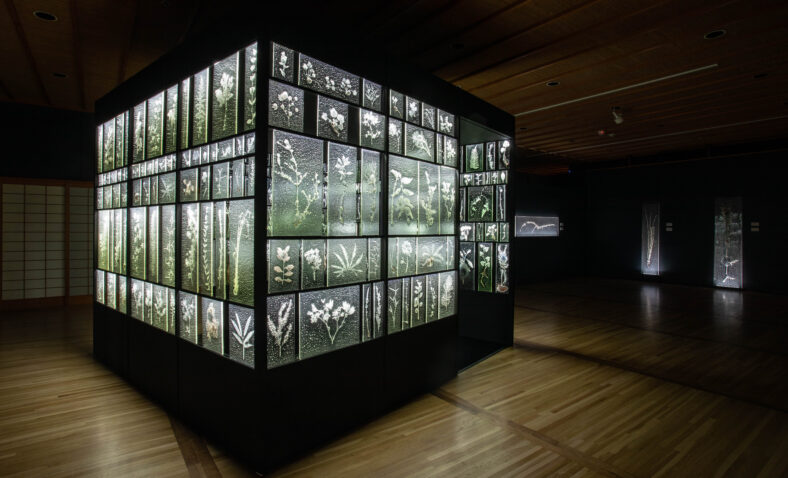
In April, author, critic, and curator Richard Speer reviewed Subtle Intimacy: Here and There, Portland Japanese Garden’s first new art exhibition of 2023 for Visual Art Source, a digital art platform that covers art venues and their exhibitions in the Western United States from the West Coast to Chicago. This exhibition features the work of Japan Institute’s inaugural Artist-in-Residence, Rui Sasaki and runs through June 12. Below is Speer’s review of Subtle Intimacy, re-published with his permission.
Rui Sasaki, “Subtle Intimacy: Here and There”
Portland Japanese Garden, Portland, Oregon
Review by Richard Speer
At first glance and at a distance it conjures the Kaaba, the sacred black cube visited by Islamic pilgrims in Mecca, the rest of Saudi Arabia, as if seen by moonlight, rising from a mirror-smooth plane into inky night skies. As one approaches more closely, one might wonder whether one has stumbled into the laboratory of some mad botanist bent on the esoteric taxonomy of exotic plants. Rui Sasaki’s site-specific installation, “Subtle Intimacy: Here and There,” lends itself readily to such fanciful readings, occupying the intersection of vegetal science and the provinces of poetry and philosophy.
This is familiar territory freshly reimagined for Sasaki, who was born in 1984 in Japan and schooled at Musashino Art University (Tokyo) and Rhode Island School of Design. The overarching comprehension of her chosen media, glass and light, rests upon a conflation of glass with water and light with the ever-shifting atmospherics of her home base in Kanazawa, reputedly the rainiest city in the Japanese archipelago. The mutable boundaries between meteorology, phenomenology, and art-making figure prominently in the gee-whiz objects and installations that have put this artist on the art-world radar. There’s undeniable curb appeal to her darkened rooms replete with supersized raindrops, turquoise-hued vessels, sea urchin-like forms, and bioluminescent chandeliers, first exhibited in the pandemic year of 2020.
That’s the year The Japan Institute and the National Endowment for the Arts engaged Sasaki, with curator Aki Nakanishi, to travel to Portland as the Japanese Garden’s first artist in residence. After a two-year delay, courtesy Covid lockdowns, she spent a pair of two-month stints here, one in summer, the other in winter, soaking up the garden’s seasonal ambiance. …Sasaki gathered clippings of bamboo, ginkgo, maple, sword fern, maiden-hair fern, vine maple, and a plethora of other varietals. She carted these clippings, along with others she’d brought with her from Japan, from the garden’s grounds in Washington Park down the West Hills to the southeast Portland headquarters of Bullseye Glass. There, working with Ted Sawyer, Bullseye’s director of research and education, and his team of assistants, she placed the plants and bulbs between large glass panes, then fed them into large kilns, where extreme heat incinerated them. Only ghost images remained, byproducts of vaporization and ash, silica silt eternalized in a crematorium for flora transmuted into art.
Afterwards Sasaki secured the 235 completed images into the scaffolding of an open cube, with LEDs hidden inside the metal structure to illuminate the panels. Some of the panels are clear, others greenish, all are resplendent with myriad bubbles, a natural byproduct of their time curing in the kiln. Those bubbles evoke oxygen seeping from underwater springs or the off-gassing of a SCUBA diver’s regulator mouthpiece, reinforcing the glass/water conflation so central to this artist’s practice. The cube’s highly reflective flooring, made from aluminum composite panels, also resembles water, lending the appearance of a silky, unrippled lake surface. The structure itself, with its traditional proportions and square footprint, resembles a stylized tearoom, or chashitsu, common to Japanese homes and temples.
The overall effect is dreamy, mesmerizing, and more than a little elegiac. Sasaki has spoken and written about the homesickness, culture shock, and reverse culture shock she experiences traveling back and forth between Japan and the U.S. To long for a place or person is to be hyper-aware of their absences, which can sear sharply into one’s consciousness or ache dully, if no less insistently. The plants memorialized in these glass panels died twice to become art: once when they were severed from the earth and again in their trial by fire. Viewing them, we note the paradox of chloroplast turned into memory, material form changed into an immaterial marker.
Japanese philosophy has words for many types of emptiness. One is “ma” (間), a gap of space or time between two objects or concepts. Another is “mu” (無), the complete absence of any referent. The gap between East and West, and the bleak emptiness outside the grounding comfort of “home,” are phenomena that Sasaki experiences as corporeal sensations, as pits in the core of the body. This, we infer, may be why she uses the visceral term “intimacy” in the titles of this and other exhibitions. The absences are personal and bodily. She invites us as viewers to feel some approximation of what she does. To walk through a glowing, immersive cube, surrounded on either side by essentially the death masks of Japanese and American fronds and flowers, is to physically enter a space between cultures, a space where metaphor becomes material.
Richard Speer is an American author, art critic, and curator. Information on the articles and books Speer has written, as well as exhibitions he has curated, can be found on his website, richardspeer.com.